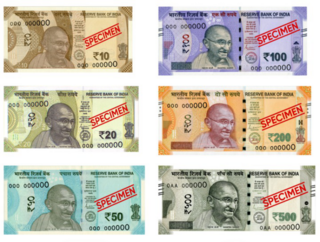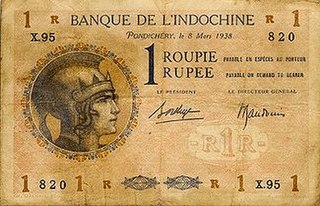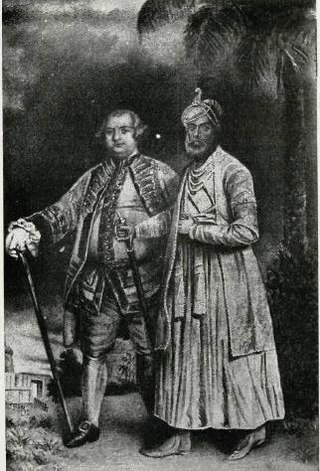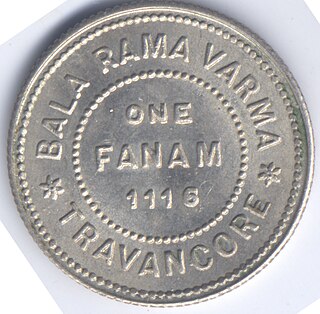
The Kingdom of Travancore, also known as the Kingdom of Thiruvithamkoor or later as Travancore State, was an Indian kingdom that lasted from c. 1729 until 1949. It was ruled by the Travancore Royal Family from Padmanabhapuram, and later Thiruvananthapuram. At its zenith, the kingdom covered most of the south of modern-day Kerala and the southernmost part of modern-day Tamil Nadu with the Thachudaya Kaimal's enclave of Irinjalakuda Koodalmanikyam temple in the neighbouring Kingdom of Cochin. However Tangasseri area of Kollam city and Anchuthengu near Attingal in Thiruvananthapuram were parts of British India.

Rupee is the common name for the currencies of India, Mauritius, Nepal, Pakistan, Seychelles, and Sri Lanka, and of former currencies of Afghanistan, Bahrain, Kuwait, Oman, the United Arab Emirates, British East Africa, Burma, German East Africa, and Tibet. In Indonesia and the Maldives, the unit of currency is known as rupiah and rufiyaa respectively, cognates of the word rupee.

The Indian rupee is the official currency in India. The rupee is subdivided into 100 paise. The issuance of the currency is controlled by the Reserve Bank of India. The Reserve Bank manages currency in India and derives its role in currency management based on the Reserve Bank of India Act, 1934.

The Pakistani rupee is the official currency in the Islamic Republic of Pakistan. The issuance of the currency is controlled by the State Bank of Pakistan. It was officially adopted by the Government of Pakistan in 1949. Earlier the coins and notes were issued and controlled by the Reserve Bank of India until 1949, when it was handed over to the Government and State Bank of Pakistan, by the Government and Reserve Bank of India.

The Coinage of India began anywhere between early 1st millennium BCE to the 6th century BCE, and consisted mainly of copper and silver coins in its initial stage. The coins of this period were Karshapanas or Pana. A variety of earliest Indian coins, however, unlike those circulated in West Asia, were stamped bars of metal, suggesting that the innovation of stamped currency was added to a pre-existing form of token currency which had already been present in the Janapadas and Mahajanapada kingdoms of the Early historic India. The kingdoms that minted their own coins included Gandhara, Kuntala, Kuru, Magadha, Panchala, Shakya, Surasena, Surashtra and Vidarbha etc.

Coins of the Indian rupee (₹) were first minted in 1950. New coins have been produced annually since then and they make up a valuable aspect of the Indian currency system. Today, circulating coins exist in denominations of One Rupee, Two Rupees, Five Rupees, Ten Rupees and Twenty Rupees. All of these are produced by four mints located across India, in Kolkata, Mumbai, Hyderabad, Noida.

The roupie or rupee was the currency of French India. It was equal to the Indian rupee issued by the Indian government. One rupee was worth 2.40 francs-or. Until 1871 it was issued as coins with the roupie divided into 8 fanons, each of 3 doudous or 20 cash. From 1891, banknotes were issued by the Banque de l'Indochine, which circulated alongside coins issued by British India.

The history of the rupee traces back to ancient times in the Indian subcontinent. The mention of rūpya by Pāṇini is seemingly the earliest reference in a text about coins. The term in Indian subcontinent was used for referring to a coin.

The rixdollar was the currency of British Ceylon until 1828. It was subdivided into 48 stivers, each of 4 duit. Units called the fanam and larin were also used, worth 4 and 9½ stiver, respectively. The currency derived from the Dutch rijksdaalder and stuiver, although the rijksdaalder was worth 50 stuiver.

The provinces of India, earlier presidencies of British India and still earlier, presidency towns, were the administrative divisions of British governance on the Indian subcontinent. Collectively, they have been called British India. In one form or another, they existed between 1612 and 1947, conventionally divided into three historical periods:

The Netherlands Indies guilder was the unit of account of the Dutch East Indies from 1602 under the United East India Company, following Dutch practice first adopted in the 15th century. A variety of Dutch, Spanish and Asian coins were in official and common usage. After the collapse of the VOC at the end of the 18th century, control of the islands reverted to the Dutch government, which issued silver 'Netherlands Indies' guilder and fractional silver and copper coins until Indonesian independence in 1945.

The Travancore rupee was a type of currency issued by the erstwhile Indian princely state of Travancore, which was primarily located in the modern Indian state of Kerala. The rupee was largely a newer currency in comparison to the older currencies of Kerala such as the Fanams, Achus, Chuckrams as well as the Kasu. Its creation was probably intended for the increased trading with British India and the high-value transactions therein.
Fanam was the currency used historically in major parts of South India, especially during the British Raj. Fanam is the an Anglo-Germanic sound shift from the traditional Dravidan word paṇaṁ, meaning "coin" or "wealth". It may specifically refer to:

Dutch India consisted of the settlements and trading posts of the Dutch East India Company on the Indian subcontinent. It is only used as a geographical definition, as there was never a political authority ruling all Dutch India. Instead, Dutch India was divided into the governorates Dutch Ceylon and Dutch Coromandel, the commandment Dutch Malabar, and the directorates Dutch Bengal and Dutch Suratte.

Cash is a name for several historical currencies used in Asia. It is applied to units used in China, Vietnam, and of Madras and Princely state of Travancore in British India. It is also occasionally used to refer to the Korean mun and the Japanese mon.

The pagoda, also called the hoon, was a unit of currency, a coin made of gold or half-gold minted by Indian dynasties as well as the British, the French and the Dutch. It was subdivided into 42 fanams. The pagoda was issued by various dynasties in medieval southern India, including the Kadambas of Hangal, the Kadambas of Goa, and the Vijayanagara Empire.

Madras Presidency was an administrative subdivision (presidency) of British India. At its greatest extent, Madras Presidency included much of southern India, including the present-day Indian State of Tamil Nadu, the Malabar region of North Kerala, Lakshadweep Islands, the Coastal Andhra and Rayalaseema regions of Andhra Pradesh, Undivided Koraput and Ganjam districts of Orissa and the Bellary, Dakshina Kannada, and Udupi districts of Karnataka. The presidency had its capital at Madras.

Coinage under British governance of the Indian subcontinent can be divided into two periods: East India Company (EIC) issues, pre-1835; and Imperial issues struck under direct authority of the crown. The EIC issues can be further subdivided into two subcategories: the Presidency issues, which comprise separate Madras Presidency, Bombay Presidency, and Bengal Presidency issues; and uniform coinage for all British territories from 1835 to 1858. Imperial issues bear obverse portraits of Queen Victoria, Edward VII, George V, and George VI. No British India coins were issued during the brief reign of Edward VIII.

The Travancore Fanam was a type of money that was issued by the State of Travancore, now mainly a part of Kerala in South India. The Fanams and Chuckrams were known to be some of the smallest coins in the world. The word Fanam appears to be an Anglo-Germanic sound shift from the word Panam, which means money in Dravidian languages. Historically, the Fanam and Chuckram coins were the regular unit of currency in medieval Travancore and appear to have been extensively used for trading in the region of South India. The words Fanam and Panam literally mean money and are still used as a synonym for wealth in Kerala in the native language of Malayalam.

The Indian 1-rupee coin (₹1) is an Indian coin worth one Indian rupee and is made up of a hundred paisas. Currently, one rupee coin is the smallest Indian coin in circulation. Since 1992, one Indian rupee coins are minted from stainless steel. Round in shape, the one rupee coins weighs 3.76 grams, has a diameter of 21.93-millimetre (0.863 in) and thickness of 1.45-millimetre (0.057 in). In independent India, one rupee coins was first minted in 1950 and is currently in circulation.



















